AFRICAN SAFARI
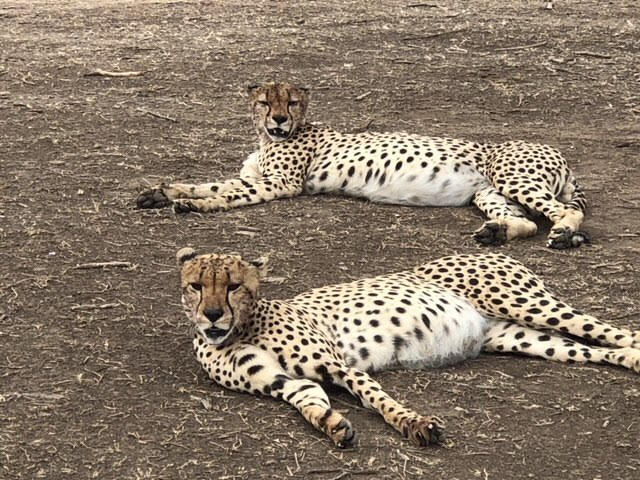
IT SUCKS TO BE A CHEETAH
You may have known that the cheetah is the fastest land animal, capable of going from zero to sixty miles per hour in three seconds. But did you know that the cheetah is considered “vulnerable,” meaning that the cheetah population has declined to the point where it’s on the verge of being added to the endangered species list? [1] Why? Despite their lightning speed, cheetahs are not the strongest animals; they’re preyed upon by lions, leopards, and hyenas. Unlike leopards, cheetahs do not have retractable claws so they can’t climb trees to escape their predators’ attacks; their defenseless cubs are especially likely to be devoured. And if that’s not trouble enough, after cheetahs make a kill, they’ve got to gulp down their dinner as quickly as possible before other animals—even vultures—show up and try to steal their meal. Because cheetahs have relatively small jaws compared with other big cats, it’s not uncommon for cheetahs to abandon their food in the face of aggressive bullies, forcing them to expend the energy to hunt again without adequate nutritional refueling. No wonder why cheetahs are finding it so hard to survive.
Sucks to be a cheetah, right? I had no idea until Kristina Tao told me the facts I just imparted to you. I had always thought it would be sexy to be a cheetah, whizzing around like a bitchin’ Camaro, sinking my claws into flesh, luxuriating in my fabulous coat, the envy of the savanna. But as it turns out, there’s no glamour in being a cheetah; the only thing cheetahs have in common with supermodels is the eternal hunger part! It was Kristina who enlightened me and totally changed my perspective, and not just about cheetahs, but about the entire African safari experience. Hopefully, Kristina’s story will not only open your eyes and your heart and give you a fresh new perspective too.
CHOOSEYOUR OWN ADVENTURE
Kristina Tao’s fascination with cheetahs and leopards started the way it does for most people—from watching spectacular BBC nature programs. But while most people are content to commune with nature without leaving the comfort of their couches, Kristina had the desire to immerse herself in the Animal Kingdom, “where the animals were in charge, not the humans.” A recently retired anesthesiologist and empty-nester, Kristina seized the opportunity to cross the African safari experience off her bucket list in 2019. Her husband, Brian, was totally on board, and he hadn’t even watched any of the BBC shows!
A financial engineer by profession, Brian adopted the role of “travel agent,” researching flight and lodging information and communicating with tour companies. The Taos eventually selected a tour operator based out of Nairobi, Kenya, called Asili Adventure Safaris, that flexibly accommodated the Taos’ atypical requests.[2] Whilethe standard safari is 7 days long, the Taos extended their trip to 10 days in order to increase their chances of animal sightings. Instead of just traveling to one country like most safari-goers, the Taos opted to visit two countries; specifically, Maasai Mara National Reserve in Kenya and Serengeti National Park in Tanzania[3]because different types of animals live in these distinct habitats, thereby boosting the probability of viewing a greater variety of animals. Following similar logic, the Taos deliberately chose to go on safari in August when it is “the peak of Spring, the greenest time, when the grass isn’t too high yet, so you can see the animals better.”
SCOUT’S MOTTO – “BE PREPARED”
Kristina emphasized important health and safety precautions you should take before going on safari, including a mandatory yellow fever shot, and a physician-recommended regimen of antimalarial antibiotics starting 2 days before departure and ending one week after return. Essential travel items in their suitcase were sunblock, brimmed hats, and plenty of mosquito repellent. But there’s one item no one advised them to bring that Kristina highly recommends—a face mask to prevent inhalation of tiny particles while driving along dusty roads![4]
Airfare wasn’t included in Asili’s package, requiring the Taos to arrange their flight well in advance of their tour dates. Brian booked a flight with a Zurich layover because there were no direct flights from the U.S. He also reserved an Airbnb that offered transportation to and from the Nairobi airport. This way, they got a good night’s sleep before their driver picked them up the next morning to begin their great adventure!
GLAMPING SAFARI STYLE
Safari tourists typically behave like gypsies, moving from one tent village to another in pursuit of animals, and the Taos were no exception. Kristina and Brian usually only stayed one night at each tent village, but occasionally, they stayed for 2 or 3 nights in order to increase their chances of spotting certain creatures that were known to frequent a particular area. “But you don’t have to pick up your tent and move it with you.” Kristina said. “The tents are permanent structures and although they have canvas walls, you would never know it.” Canvas is an ideal material for blocking the sun and providing air flow; the zip-up entrance keeps out the mosquitos and pesky monkeys who wouldn’t hesitate to “trash your belongings in search of food!”
Their swanky living accommodations defied Kristina’s expectations. Roughly the size of a 2-car garage, each tent was equipped with modern amenities, including a king-sized bed, double sinks, and a tile shower! “Mosquito nets over the bed were VERY important,” she emphasized. Sanitary conditions were much better than Kristina had expected too. Everything was clean and they were provided with fresh towels and linens upon request. The Taos made sure to leave a few dollars for their housekeepers each time they checked out of a tent village as they would do in a hotel.
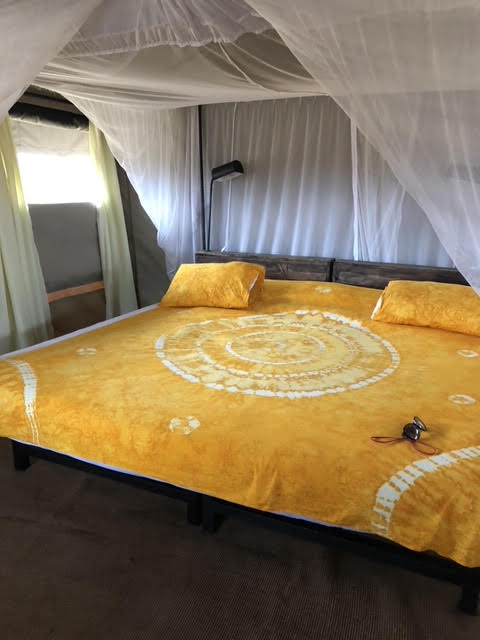
Initially concerned about what the food would be like, Kristina and Brian were pleasantly surprised to find nutritious, flavorful meals made with fresh organic local ingredients. First, you were served a tasty pumpkin or vegetable soup, which was Kristina’s favorite part of the meal. Next, you could go to the buffet, where you could choose free-range poultry or grass-fed meat (occasionally, there was fish or lamb), a staple such as rice, potatoes, or bread, and root vegetables. Brian was particularly fond of the “wonderful honey on fresh bread.” Their diet was so well balanced that Kristina never had to open the beef jerky from Costco she had packed just in case they didn’t get enough protein. The food on Safari “was the ideal healthy diet people strive to achieve.” Plus, they never sufferedfrom any food poisoning or digestive troubles!
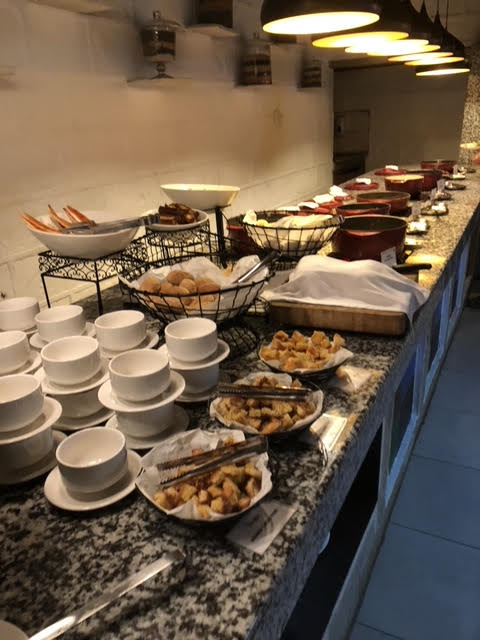
Kristina admitted that at first she was scared to go to sleep at night surrounded by noisy wild animals! “You can hear hyenas howling in the distance and feel the heavy vibration of a male lion’s roar. What happens if they crash into your tent?” she wondered. But after a while, she got used to the creature chorus, acknowledging that the animals were not intruders. “It was we humans who were intruding upon their territory.” Eventually, Kristina and Brian got used to living with their animalneighbors so much that they actually enjoyed it. One morning, “we woke up to find 3 gazelles grazing right beside our tent,” and another time, while walking to the dining hall for breakfast, “we were ambushed by a monkey gang looking for food, which we found amusing.”
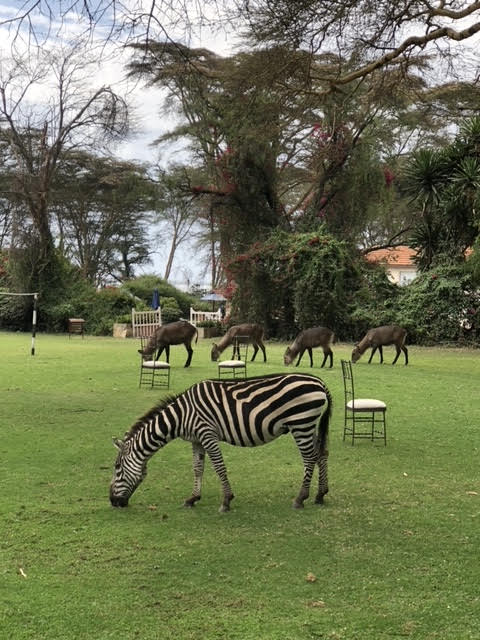
BABY, WON’T YOU DRIVE MY JEEP?
Jeep drivers for safari tour companies hold high social status in Kenya and Tanzania, not only because they cater to tourists who support the local economy, but also because they’ve got to be good at wearing many hats. Besides being able to handle tank-like vehicles in difficult driving conditions, they’ve got to be resourceful mechanics, tour guides who can communicate with guests from all over the world, experts in animal behavior, and medics in emergency situations.
In Kristina’s opinion, the success of your Safari experience is largely dependent on the competency of your driver. [5] But it is also important that you clearly state your priorities, hopes, and fears from the outset so that your driver will be better able to customize your adventure according to your individual preferences. Asili provided the Taos with one driver for the Kenyan portion of their tripand a different driver for the Tanzanian portion. Kristina wasn’t shy about informing both drivers that their number one priority was to see the greatest variety of animals they possibly could, and that they were especially hoping to see cheetahs and leopards. Her Kenyan driver knew she was dead serious when Kristina offered to get up as early as 3:00 am and skip the dining room entirely to get a jump start on spotting nocturnal hunters (especially leopards) and migrators who preferred coming out of hiding in the silent hours before the swarming jeep traffic. Her driver told Kristina that it was too dangerous to drive into the park that early in the morning because the roads aren’t lit and they’re terribly bumpy. But he offered to give them the earliest possible departure time each morning, which necessitated talking to the kitchen staff to make take-out breakfast and lunch arrangements.
So while most travelers were still snoozing, Kristina and Brian jumped into their jeep barely before sunrise at 6:00 am, with 2 small paper bags each (one for breakfast and one for lunch) and a thermos filled with coffee or tea. Kristina usually opted for tea, but one morning she chose coffee, which went through her system faster; when she anxiously told her driver she needed him to stop, he was sensitive to her situation, saying: “We must all answer nature’s call!” and found a parking spot that offered Kristina some privacy, or so she thought, until she realized an ostrich was standing a few yards behind her! “If there had been a group of ostriches there, that would have been dangerous,” says Kristina, “but only one ostrich, that was fine,” she laughed. So the moral of the story is: choose tea!
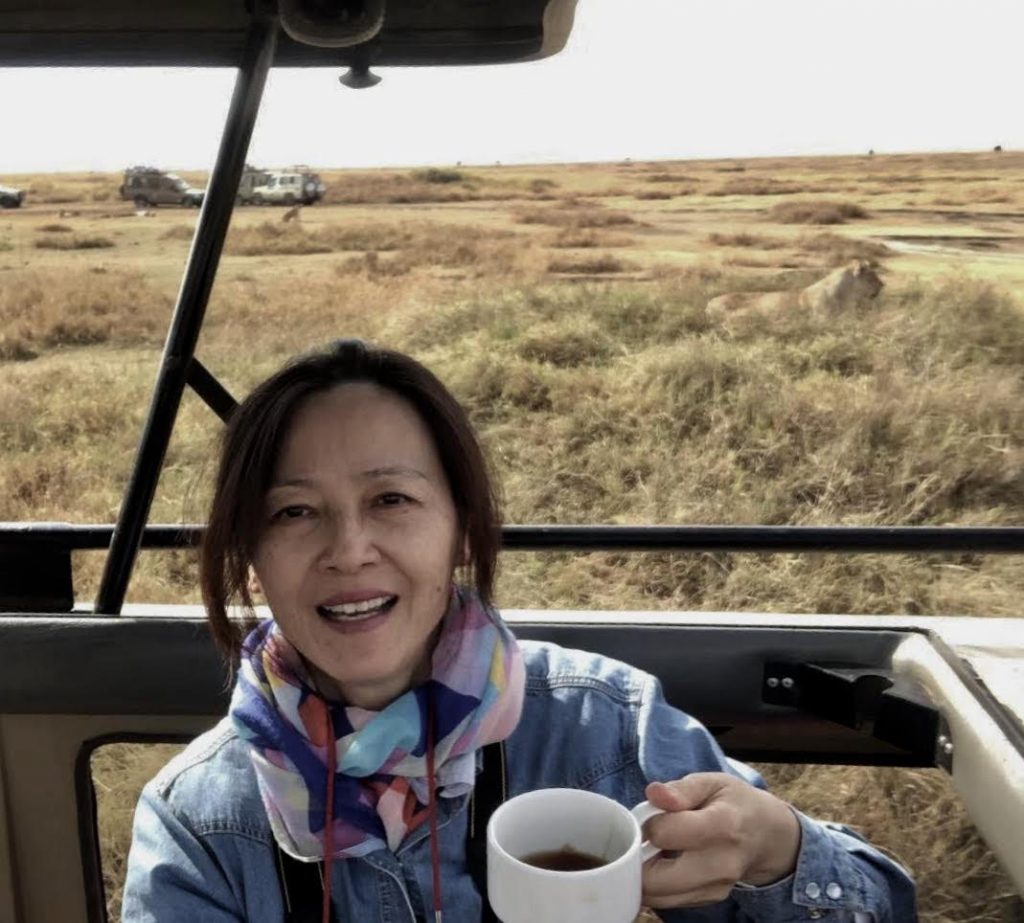
THE PAYOFF IS WORTH THE PRICE
Kristina’s driver wasn’t joking when he said that the condition of the roads leading in and out of the national parks and the road system within the parks present challenges for drivers and passengers alike. Whirlwinds of dust make for poor visibility and can create respiratory difficulties if you inhale too much dust when your windows are rolled down; hence, Kristina’s recommendation to wear a face mask! Huge ruts in the road created by hundreds of intersecting jeep tire tracks get filled in by tiny stones, requiring jeep drivers to cut their wheels at an angle to traverse the rough surface, producing a jarring “bump, bump, bump” effect on the passengers, especially at faster speeds. Admittedly, it’s the polar opposite of a smooth ride, but it’s well worth it, Kristina says. Jeep drivers talk to each other on the radio all day, communicating intelligence on animals’ exact locations. “Sometimes you have to drive fast in order to get up close to them before they move on,” says Kristina. “And you’re grateful your driver got you there in time.” Witnessing the great migration[6], Kristina poked her head out of the roof of her jeep so that she could get a 360 degree view, and was shocked to see thousands of animals surrounding their jeep! Awestruck, she realized: “We’re like ants to them, barely even noticeable. Because this is THEIR KINGDOM. They have their own lifestyle and social order and we humans have no control over it. We don’t matter here.”
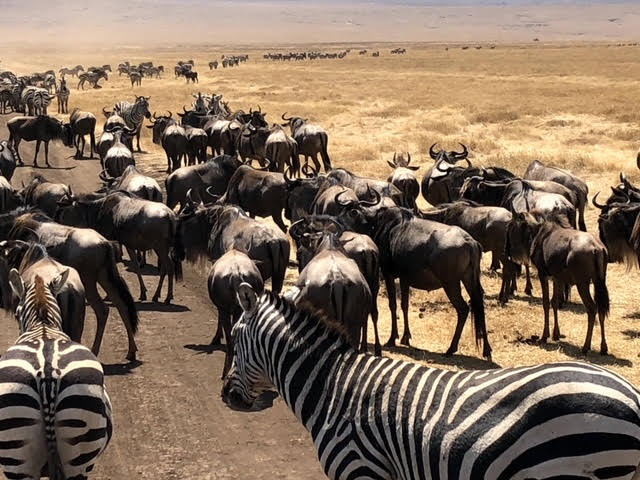
THE HUMAN CONDITION
The Maasai are a semi-nomadic pastoral tribe inhabiting the African Great Lakes region whose lives revolve around their cattle herds, which they believe are a gift from God.[7]Watching Maasai herdsmen by the roadside grazing their cattle in volcanic ash-enriched soils piqued Kristina and Brian’s curiosity, and they decided to visit a Maasai village. Their driver told them that lions were the greatest enemy of the Maasai because lions killed their cattle, and traditionally, a Maasai boy had to prove his manhood by killing a lion and wearing its teeth around his neck; only then could he marry as many wives as he could afford to keep. Now, Maasai elders discourage this coming-of-age ritual due to laws prohibiting lion hunting, but polygamy is still alive and well in Maasai country because a man’s success is not only based on how many head of cattle he has, but also how many children he fathers. Multiple wives guarantee the likelihood of more children and greater social status. Ironically, the Maasai hierarchy resembles that of their nemesis, the lion, where each male rules over a pride of females and cubs.
After making a donation to the chief, whom Kristina suspected of “swallowing their money,” the Taos were allowed to enter a typical Maasai house. At first, it was so dark inside that at first Kristina could not see a thing! After her eyes adjusted, Kristina suddenly she realized there was a mother nursing a baby right next to her! “It was such a tiny room,” Kristina recalled, “maybe 5 by 6 feet across, with no windows or ventilation except for a mug-sized open hole in the roof.” There was no furniture, just an open fire with an aluminum pot, and 2 pieces of clothon the ground that served as a bed. Kristina felt “very sad” to witness such austere living conditions. Kristina explained that when a Maasai woman is ready to marry, she must build her own home by digging a ditch, setting up a circle of sticks in the ground, adding mud to the walls, and lashing it all together. Then, she’s got to wait around hoping for a man to show up! I’m thinking I’d rather be a cheetah.
WHY DON’T WE DO IT IN THE ROAD?
On the Tanzanian portion of their tour, Brian and Kristina opted for take-out breakfast and lunch too. One morning, their driver parked so that they could enjoy a bounce-free breakfast, and while Kristina was peacefully drinking her tea, she suddenly noticed a male lion standing right next to their rear window! A lioness was standing behind their jeep like a lookout! Kristina explained that only lionesses hunt as a team; the male’s job is to ward off potential threats to the safety of the pride; that’s why grazing prey animals like gazelles and wildebeest don’t run scared from roving male lions.
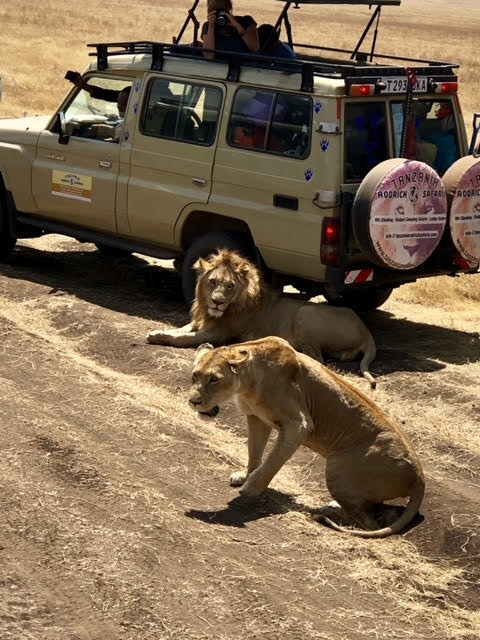
As it turns out, most safari tourists see lots of lions because they’reeverywhere, “like deer,” says Kristina. They really do “act like kings” and they have no problem having sex like no one is looking! Near the Ngorongoro Crater, Kristina and Brian saw a pair of lions “make love” 7 times by the roadside, after which they took their sweet old time crossing the road, completely stopping traffic. Apparently, the average lion copulates 30-40 times a day during mating season.[8] “Lions rest a lot to conserve energy,” Kristina told me. No wonder they would need to rest if they’re that busy getting busy!
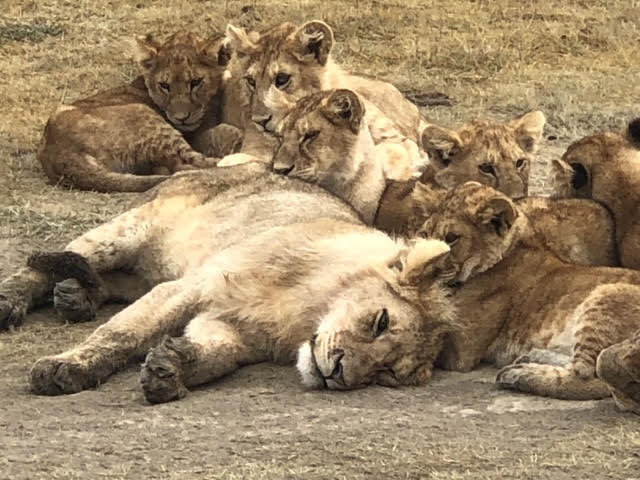
SHE PERSISTED
Another day in Tanzania, while driving along a low section of road that had been flooded due to heavy rains the previous evening, their jeep got stuck in the mud! Kristina worried that they would have to get out of the vehicle, giving the animals an opportunity to attack. Discouraged, Kristina wouldn’t have minded returning to camp if their driver would have suggested it. But what seemed like a big deal to her was only a minor setback to their experienced driver, who convinced Kristina to keep on going, “luckily for us!” Soon after another jeep arrived and helped them out of the ditch, they spotted 2 beautiful cheetahs! And these were not the first cheetahs she saw, Kristina reminded me. First, there was the “feeding cheetah” she saw in Kenya. From 15 feet away, Kristina could hear the sound of bonescrunching as the cheetah chowed down. I guess the lesson here is that you’ve got to be persistent like the cheetah to enjoy the payoff.
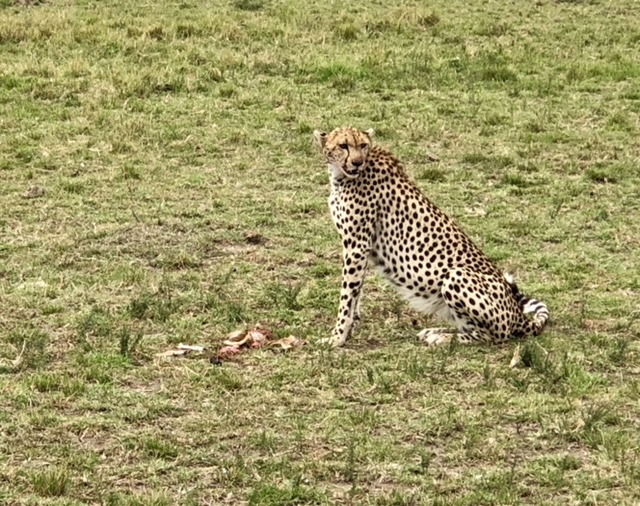
YOU DON’T WANT TO MEET A HIPPO IN A DARK ALLEY
Driving past Zebras grazing on a wide flat plain at the foot of Mt. Kilimanjaro, with its snow-capped peak, they came to a riverbed lush with palm trees overhanging the banks. Here, white birds that looked like “kind of like pelicans, and kind of like cranes[9]” were fishing while hippopotami were bathing nearby. Kristina explained that the reason why hippos are always in the water during the day is that they can get sunburned, and they use mud as their sunscreen! Hippopotami hang out in a group called a “bloat” consisting of one male, several females, and their babies. Although this scene was placid enough from a distance, Kristina and Brian didn’t get too close because they had already been warned that hippos can get aggressive towards humans who invade their territory. “Once, we camped by a lake where hippos grazed in the common area between the tents. In every tent, there was a phone so that guests could call security to escort them through the common area at night,” which Kristina found very reassuring, because getting attacked by a hippo is no bueno.[10]
DEAF LEOPARD
On one memorable occasion, while waiting for a herd of gazelles to show up and cross the river, their driver heard some radio intel that prompted him to suddenly turn around and drive so fast that Kristina and Brian had to stand up hold onto their seatbelts. ”Brace for impact!” Kristina warned Brian,” but then they abruptly slowed down. “Look!” said their driver, pointing to a tree about 30 feet away where a leopard was sleeping like a baby on a branch. Their jeep pulled up even closer until they were only 10 feet away! Kristina worried that the sound of the engine would startle the leopard, but their driver reassured her that leopards are so accustomed to jeeps that he won’t feel threatened. Spellbound, Kristina and Brian watched the leopard for 15 minutes, and sure enough, he didn’t seem to notice that they were there. He barely moved, except for a little leg twitch. He didn’t even open his eyes. But Kristina’s eyes were full of “tears of joy thatwent streaming down her cheeks.” Leopards are THE most difficult animals tospot in the savanna. Because they hunt nocturnally, you rarely see them by day and when you do, their spotted coats blend into the grasses so that you can barely get a glimpse of them. Kristina was struck with the realization that she was witnessing something incredibly rare. Her greatest wish for her safari adventure had been fulfilled and she felt fortunate indeed!
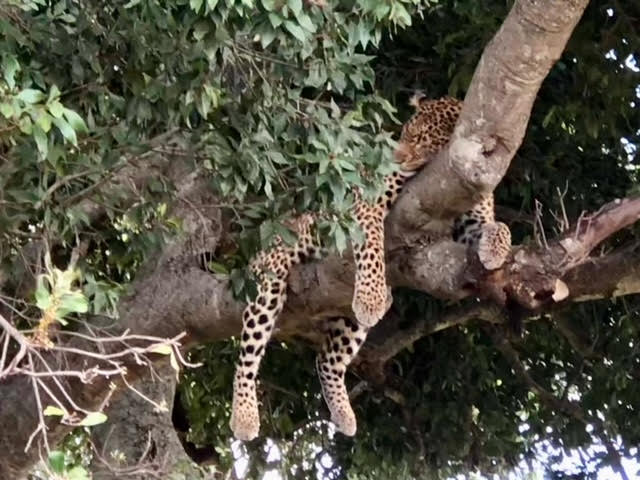
HURRY BOY, SHE’S WAITING THERE FOR YOU
If you think you’ll never get to go on safari because it’s prohibitively expensive, think again! Remember that both Kenya and Tanzania are trying hard to attract tourists and the cash they pump into the regional economy, so bargain hunters can definitely find good deals. Kristina notes that the cost of a safari tour package can vary widely, depending on the travelers’ priorities and the level of luxury they desire. For example, the cost of Kristina and Brian’s package was $3,720 per person, which included food and lodging, as well as daily jeep tours. Kristina’s friend paid $20,000 more for her posh package, where “they set up a table with white linens and chilled wine,” Kristina said, “but she didn’t see any leopards or cheetahs.”
Kristina passionately believes that “everyone who loves nature” should go on an African safari adventure at least once in their lives. “I highly recommend it. There’s no place else on earth where the animals are in charge and you are just an observer,” she says. “It’s a life-changing experience that humbles you. It’s unique. There’s nothing comparable.” Kristina made me promise that I would go someday. Now, all I’ve got to do is find a way to turn that promise into a reality. Easier said than done, but so much easier than being a cheetah!
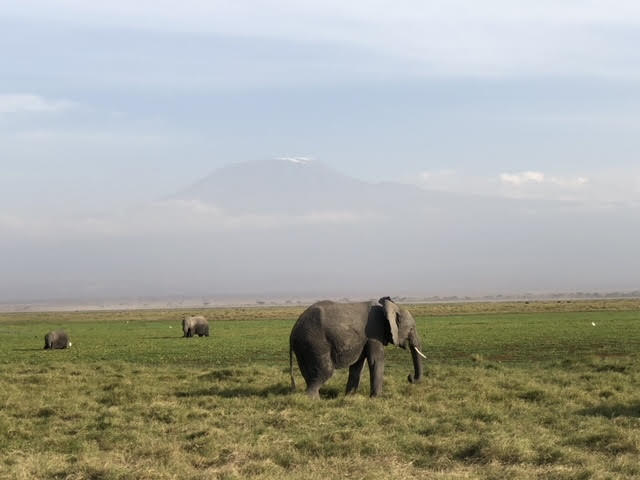
[1] For facts about cheetahs and the survival challenges they face, see https://education.nationalgeographic.org/resource/cheetahs-brink-extinction-again/
[2] For more information about Asili Adventure Safaris, see https://www.asiliadventuresafaris.com/
[3] To learn more about Maasai Mara and Serengeti, see https://en.wikipedia.org/wiki/Maasai_Mara and https://en.wikipedia.org/wiki/Serengeti_National_Park
[4] Remember, Kristina &Brian went on safari in pre-COVID days, before face masks for travelers becameubiquitous.
[5] Itis customary for safari tourists to offer a minimum gratuity of $100 to theirdrivers at the conclusion of their tour. The Taos were so pleased with theirdrivers that they gave each of them $200.
[6]Thousands of wildebeests, eland, zebras, and gazelles migrate from the Serengetiinto Maasai Mara from July through October, which, are the most popular monthsfor the tourists herds too. https://www.masaimara.com/great-migration-kenya.php
[7]For detailed information about the Maasai people, see https://en.wikipedia.org/wiki/Maasai_people.
[8] Thiswebpage from the San Diego Zoo contains fascinating scientific data about lions,including their reproductive and child-rearing behavior. https://ielc.libguides.com/sdzg/factsheets/lions/reproduction
[9] Justspeculating, but I think these birds were yellow-billed storks. https://en.wikipedia.org/wiki/Yellow-billed_stork
[10]Ok, so maybe its sensationalized, but you won’t be able to stop reading thisarticle about a canoe safari guide who was unlucky enough to get attacked by ahippo. https://nypost.com/2022/03/14/a-hippo-ripped-off-my-arm-and-threw-me-around-like-a-rag-doll/
